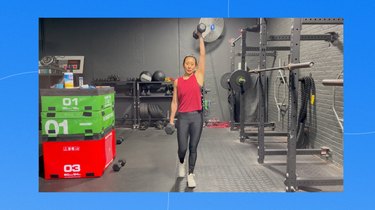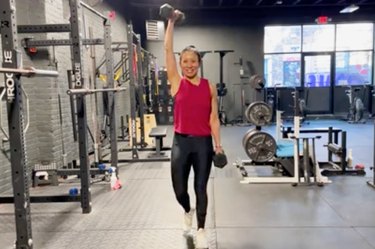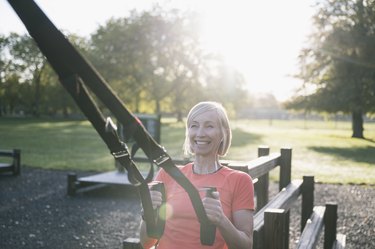


Grab two dumbbells (ideally one's heavier than the other), raise one straight overhead, then get walking.
It might sound simple, but the offset waiter's carry exercise is truly one of the best moves you can do to build shoulder stability, grip strength and even core health as you age, Tina Tang, CPT, a certified personal trainer who specializes in healthy aging, tells LIVESTRONG.com.
Video of the Day
You need strong, stable shoulders to do everyday tasks like lifting objects overhead or reaching your back to wash it, not to mention feeling your best in any number of sports. Your grip also has to be strong to hold, carry, lift and pull… anything. And the only thing keeping you from tipping over during the waiter's carry — or daily life? Your core.
So, if you want to build or maintain these strengths through the years, the offset waiter's carry (also known as a "walk") will get you squared away.
Warning
Skip the overhead carry part of this exercise if you experience shoulder pain and/or you’re recovering from a shoulder injury. Work with your physical therapist instead to learn how to safely strengthen the muscles surrounding this joint. The farmer's walk is a great alternative for anyone with cranky shoulders.
How to Do the Offset Waiter’s Carry
Tang recommends doing the offset waiter's carry one to two times per week.
If you're folding it into your workouts, schedule it at the end of a full-body strength training workout or use it as a core exercise in a circuit-style routine.
Tang suggests starting with a weight in the overhead position that you can comfortably press. Once that becomes easy, go with a weight you can raise by using your legs for a momentum assist. For the weight you hold down by your side, pick one that's at least 5 pounds heavier than the weight overhead.
Carry the lighter weight in the overhead position and the heavier weight in the suitcase position, down at your side, and then set the weights down and swap sides.
Carry for up to 30 seconds per side. Don't try to carry the weights farther or longer than you're able. Stop the exercise if you struggle to keep your arm locked out in that overhead position, your grip starts to give out or your lower back begins to arch
- Stand with your feet hip-width apart and hold a dumbbell in each hand down by your sides, palms facing in.
- Clean the lighter weight to your shoulder: Hinge at your hips to lower the dumbbell to mid-thigh. Then, extend forcefully through the hips while shrugging the dumbbell upward. Catch the dumbbell at your shoulder and land with a slight bend in your knees.
- Straighten your knees and press the lighter weight overhead until your elbow is locked out. Keep your wrist straight and in line with your shoulder, and your biceps next to your ear.
- Brace your core for a neutral spine and begin walking.
- Take controlled steps and look forward the whole time. Engage your core to prevent your torso from tilting in either direction.
- Tighten your grip on the weight overhead if you feel your elbow give a bit.
- Walk for time or distance.
Tip
Have limited space? Try offset marches. Hold the weights in their respective positions and march in place. “It’s almost like exaggerated walking — you’re bringing your knees all the way up to your bellybutton,” Tang says.
If you can’t comfortably press and hold weight overhead with your elbow locked out, hold the weight in a front-rack position (against the front of your shoulder, palm facing in). You’ll work your biceps, shoulders and core, without risk of shoulder pain or re-injury.
Why the Offset Waiter’s Carry Is the Best Shoulder Stability and Grip Exercise for Healthy Aging
1. It’s Functional
You could argue that the offset waiter's carry translates more easily into everyday movements than traditional gym exercises like deadlifts. After all, most of us don't pick up heavy objects with two hands with perfect deadlift form daily. You probably pick things up with one hand and carry it to your destination, Tang says. Think: shopping bags, purses, suitcases and toddlers.
If you want to keep picking those things up — or handle heavier loads — you have to practice, practice, practice.
Granted, you probably don't carry things overhead too often. But there are plenty of everyday benefits to that portion of the offset waiter's carry — provided you have the shoulder strength and mobility needed to pull it off safely, of course. (We'll get into that next.)
2. It’s Great for Shoulder Health
Holding a weight overhead while you walk lends a serious challenge to your shoulders. It recruits your bigger deltoid muscles, as well as the smaller stabilizer muscles that surround your shoulders. You wind up building hardcore shoulder mobility and stability.
Unfortunately, many of us don't spend a lot of time with our arms overhead, which leads to a gradual loss of shoulder mobility and stability. Then, when we do need to reach overhead — like when storing our carry-on in the overhead bin or getting a box of holiday decorations off the top shelf — we either can't manage it or we handle it terribly. Either scenario is a recipe for shoulder pain or injury.
In fact, shoulder pain is one of the most common musculoskeletal complaints, and the likelihood of shoulder pain only increases with age, according to a September 2019 systematic review in the European Journal of Pain.
This is where overhead exercises like the offset waiter's carry come in handy.
"If you ever have a rotator cuff injury, which is probably everyone over 40, the overhead carry is actually something they do in rehab," Tang says. You may not press a heavy weight overhead, but you'll work on locking out your elbow and holding it in that position while you rebuild your shoulder stability, she adds.
That said, you should delay the overhead portion of the carry if you can't keep your arm straight.
"When holding the weight overhead, your wrist should be right above your elbow, and your elbow should be right above your shoulder joint. That's the ideal position," Tang says. "If you're not able to do that, then the front-rack carry is best."
3. It Strengthens Your Grip
According to Tang, the carry hones in on key gripping muscles in your hands and forearms, especially in the arm down by your side.
Building grip strength will not only make it easier to unscrew stubborn jars, open heavy doors and even set a new personal best in the deadlift, but it may also mean a longer life.
A May 2015 study in Lancet found that grip strength is a reliable method for measuring overall muscular strength. As low muscular strength is associated with a greater risk of death by heart disease and any cause, your grip status can tell you where you stand.
What's more, researchers say grip strength may be a better predictor for heart disease than systolic blood pressure (how much force your blood exerts against your artery walls when your heart beats).
So, get a grip!
4. It Builds Balance
Offset exercises like this waiter's walk variation, in which you hold one weight overhead and another at your side, force you to work harder to maintain your balance as you walk. This is a skill that becomes more critical with age, as loss of balance is one of the top culprits for injury-causing falls among older adults, according to the National Institute on Aging (NIA).
Incorporating offset exercises into your routine will help prepare you for real-life situations that compel you to catch yourself and quickly regain balance.
"You won't even have to think; it'll just come naturally because you've been practicing at the gym," Tang says.
5. It Sneaks in Some Cardio
Your heart ages just like every other muscle. To keep it healthy and slow the aging process, it's important to work it regularly, per Harvard Health.
The offset waiter's carry may not replace other cardio activities in your life, but it can add a heart-healthy element to your strength routine. Simply carrying weight will get your heart pumping, and holding a weight overhead only increases the challenge.
"Anytime your arms are overhead, that will elevate your heart rate," Tang says. Your heart has to work harder to pump blood against gravity than if your arm were at your side.
- The Lancet: "Prognostic Value of Grip Strength: Findings From the Prospective Urban Rural Epidemiology (PURE) Study"
- European Journal of Pain: "Incidence of Shoulder Pain in 40 years Old and Over and Associated Factors: A Systematic Review"
- Harvard Health: "Get Moving to Slow Cardiovascular Aging"
- National Institute on Aging: "Prevent Falls and Fractures"


